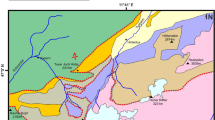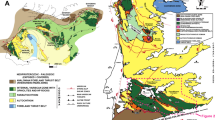Abstract
This paper presents combined U/Pb, Th/U and Hf isotope analyses on detrital and magmatic zircon grains together with whole-rock geochemical analyses of two basement and eight sedimentary rock samples from the Namuskluft and the Dreigratberg in southern Namibia (Gariep Belt). The sedimentary sections evolved during the Cryogenian on the SW part of the Kalahari Craton and where therefore deposited in an active rift setting during the break-up of Rodinia. Due to insufficient palaeomagnetic data, the position of the Kalahari Craton within Rodinia is still under discussion. There are possibilities to locate Kalahari along the western side of Australia/Mawsonland (Pisarevski et al. in Proterozoic East Gondwana: supercontinent assembly and break-up, Geological Society, London, 2003; Evans in Ancient Orogens and modern analogues. Geological Society, London, 2009; and others) or together with the Congo-Sao Francisco and Rio de la Plata Cratons (Li et al. in Prec Res 45: 203–2014, 2008; Frimmel et al. in Int J Earth Sci (Geol Rundsch) 100: 323–354, 2011; and others). It is sill unclear which craton rifted away from the Kalahari Craton during the Cryogenian. Although Middle to Upper Cryogenian magmatic activity is known for the SE Kalahari Craton (our working area) (Richtersveld Suite, Rosh Pinah Fm), all the presented samples show no U/Pb zircon ages younger than ca. 1.0 Ga and non-older than 2.06 Ga. The obtained U/Pb ages fit very well to the exposed basement of the Kalahari Craton (1.0–1.4 Ga Namaqua Province, 1.7–2.0 Ga Vioolsdrif Granite Suite and Orange River Group) and allow no correlation with a foreign craton such as the Rio de la Plata or Australia/Mawsonland. Lu–Hf isotopic signatures of detrital zircon point to the recycling of mainly Palaeoproterozoic and to a smaller amount of Archean crust in the source areas. εHf(t) signatures range between −24 and +14.8, which relate to TDM model ages between 1.05 and 3.1 Ga. Only few detrital zircon grains derived from magmas generated from Mesoproterozoic crustal material show more juvenile εHf(t) signatures of +14, +8 to +4 with TDM model ages of 1.05–1.6 Ga. During Neoproterozoic deposition, only old cratonic crust with an inherited continental arc signature was available in the source area clearly demonstrated by Hf isotope composition of detrital zircon and geochemical bulk analysis of sedimentary rocks. The granodiorites of the Palaeoproterozoic basement underlying Namuskluft section are ca. 1.9 Ga old and show εHf(t) signatures of −3 to −5.5 with TDM model ages of 2.4–2.7 Ga. These basement rocks demonstrate the extreme uplift and deep erosion of the underlying Kalahari Craton at its western margin before general subsidence during Cryogenian and Ediacaran time. The sedimentary sequence of the two examined sections (Namuskluft and Dreigratberg) proposes the presence of a basin and an increasing subsidence at the SW part of the Kalahari Craton during the Cryogenian. Therefore, we propose the initial formation of an intra-cratonic sag basin during the Lower Cryogenian that evolved later to a rift basin at the cratonic margin due to increasing crustal tension and rifting together with the opening of the Adamastor Ocean. As the zircons of the sedimentary rocks filling this basin show neither rift-related U/Pb ages nor an exotic craton as a possible source area, the only plausible sedimentary transport direction providing the found U/Pb ages would be from the E or the SE, directly from the heart of the Kalahari Craton. Due to subsidence and ongoing sedimentation from E/SE directions, the rift-related magmatic rocks were simply covered by the input of old intra-cratonic material that explains the absence of Neoproterozoic zircon grains in our samples. The geochemical analyses show the erosion of a continental arc and related sedimentary rocks with an overall felsic provenance. The source area was a deeply eroded and incised magmatic arc that evolved on continental crust, without any evidence for a passive margin. All of this can be explained by the erosion of rocks related to the Namaqua Belt, which represents one of the two major peaks of zircon U–Pb ages in all analysed samples. Therefore, the Namaqua Belt was well exposed during the Cryogenian, available to erosion and apart from the also well-exposed Palaeoproterozoic basement of the Kalahari Craton one potential source area for the sedimentary rocks in the investigated areas.








Similar content being viewed by others
References
Armstrong-Altrin JS, Verma SP (2003) Geochemistry of upper Miocene Kudankulam Limestones, Southern India. Int Geol Rev 45:16–26
Begg GC, Griffin WL, Natapov LM, O’Reilly SY, Grand SP, O’Neill CJ, Hronsky JMA, Poudjom Djomani Y, Swain CJ, Deen T, Bowden P (2009) The lithospheric architecture of Africa: seismic tomography, mantle petrology, and tectonic evolution. Geosphere 5:23–50
Bhatia MR, Crook KAW (1986) Trace element characteristics of graywackes and tectonic setting discrimination of sedimentary basins. Contrib Mineral Petrol 92:181–193
Blanco G, Germs GJB, Rajesh HM, Chemale F Jr, Dussin IA, Justino D (2011) Provenance and paleogeography of the Nama Group (Ediacaran to early Paleozoic, Namibia): petrography, geochemistry and U–Pb detrital zircon geochronology. Precambr Res 187:15–32
Bleiner D, Günther D (2001) Theoretical description and experimental observation of aerosol transport processes in laser ablation inductively coupled plasma mass spectrometry. J Anal At Spectrom 16:449–456
Bouvier A, Vervoort JD, Patchett PJ (2008) The Lu–Hf and Sm–Nd isotopic composition of CHUR: constraints from unequilibrated chondrites and implications for the bulk composition of terrestrial planets. Earth Planet Sci Lett 273:48–57
Chauvel C, Lewin E, Carpentier M, Arndt NT, Marini JC (2008) Role of recycled oceanic basalt and sediment in generating the Hf-Nd mantle array. Nat Geosci 1:64–67
Cordani UG, D’Arella-Filho MS, Brito-Neves BB, Trindale RIF (2003) Tearing up Rodinia: the Neoproterozoic palaeogeography of South American cratonic fragments. Terra Nova 15:350–359
Cox KG, Bell JD, Pankhurst RJ (1979) The interpretation of igneous rocks. G. Allan and Unwin, London 450p
Dalziel IWD (1997) Neoproterozoic-Paleozoic geography and tectonics: review, hypothesis, environmental speculation. Geol Soc Am Bull 109:16–42
Evans ADE (2009) The palaeomagnetically viable, long-lived and all-inclusive Rodinia supercontinent reconstruction. In: Murphy JB, Keppie JD, Jynes AJ (eds) Ancient orogens and modern analogues. Geological Society, London, Special Publications, vol 327, pp 371–404
Fitzsimons ICW (2002) Comparison of detrital zircon ages in the Pinjarra orogen (WA) and Maud province (Antarctica): evidence for collision of western Australia with southern Africa at 1100 Ma. Geol Soc Aust Abstr 67:228
Floyd PA, Winchester JA, Park RG (1989) Geochemistry and tectonic setting of Lewisian clastic metasediments from the early Proterozoic Loch Maree Group of Gairloch, NW Scotland. Precambr Res 45:203–2014
Frei D, Gerdes A (2009) Precise and accurate in situ U–Pb dating of zircon with high sample throughput by automated La-SF-ICP-MS. Chem Geol 261:261–270
Frimmel HE (2008) Neoproterozoic Gariep Orogen. In: Miller RMcG (ed) The geology of Namibia. Volume 2: Neoproterozoic to lower Palaeozoic. Geological Survey, Namibia
Frimmel HE, Miller RMcG (2010) Continental rifting. In: Gaucher C, Sial AN, Halverson CP, Frimmel HE (eds) Neoproterozoic-Cambrian Tectonics, global change and evolution. Deve Precambr Geol 16: 153–159
Frimmel HE, Basei MS, Gaucher C (2011) Neoproterozoic geodynamic evolution of SW-Gondwana: a southern African perspective. Int J Earth Sci (Geol Rundsch) 100:323–354
Fuck R, Brito Neves BBd, Schobbehaus C (2008) Rodinia descendants in South America. Precambr Res 160:108–126
Gaucher C, Frimmel HE, Germs GJB et al (2010) Tectonic events and Palaeogeographic evolution of Southwestern Gondwana in the Neoproterozoic and Cambrian. In: Gaucher C, Sial AN, Halverson CP, Frimmel HE (eds) Neoproterozoic-Cambrian Tectonics, global change and evolution. Dev Precambr Geol 16: 295–316
Gerdes A, Zeh A (2006) Combined U–Pb and Hf isotope LA-(MC-)ICP-MS analysis of detrital zircons: comparison with SHRIMP and new constraints for the provenance and age of an Armorican metasediment in Central Germany. Earth Planet Sci Lett 249:47–61
Gerdes A, Zeh A (2009) Zircon formation versus zircon alteration: new insights from combined U–Pb and Lu–Hf in situ LA-ICP-MS analyses, and consequences for the interpretation of Archean zircon from the Central Zone of the Limpopo Belt. Chem Geol 261:230–243
Hoffmann KH, Condon DJ, Bowring SA, Prave AR, Fallick A (2006) Lithostratigraphic, carbon (d13C) isotope and U–Pb zircon age constraints on early Neoproterozoic (ca. 755 Ma) glaciation in the Gariep Belt, Southern Namibia. Snowball Earth Conference Absract Volume, Ascona, Switzerland
Jacobs J, Pisarevsky S, Thomas RJ, Becker T (2008) The Kalahari Craton during the assembly and dispersal of Rodinia. Precambr Res 160:142–158
Li ZX, Bogdanova SV, Collins AS, Davidson A, De Waele B, Ernst RE, Fitzsimons ICW, Fuck RA, Gladkochub DP, Jacobs J, Karlstrom KE, Lu S, Natapov LM, Pease V, Pisarevsky SA, Thrane K, Vernikovsky V (2008) Assembly, configuration, and break-up history of Rodinia: a synthesis. Precambr Res 160:179–210
Ludwig KR (2001) User’s manual for Isoplot/Ex rev. 2.49. Berkeley Geochronology Center, Berkeley, Spec Publ 1a, pp 56
Martin H (1965) Beobachtungen zum Problem der Jung-präkambrischen Glazialen Ablagerungen in Südwestafrika. Geol Rundsch 54:115–127
Mawson D, Sprigg RC (1950) Subdivision of the Adelaide system. Aust J Sci 13:69–72
McDonald FA, Schmitz MD, Crowley JL, Roots CF, Jones DS, Maloof AC, Strauss JV, Cohen PA, Johnston DT, Schrag DP (2010a) Calibrating the Cryogenian. Science 327:1241–1243
McDonald FA, Strauss JV, Rose CV, Dudás FÖ, Schrag DP (2010b) Stratigraphy of the Port Nolloth Group of Namibia and South Africa and implications fort he age of Neoproterozoic iron formations. Am J Sci 310:862–888
McLennan SM (1989) Rare earth elements in sedimentary rocks: influence of provenance and sedimentary processes. In: Lipin BR, McKay GA (eds) Geochemistry and mineralogy of rare earth elements. Min Soc Am Rev Mineral 21: 169–200
McMillan MD (1968) The geology of the Witputs-Sendelingsdrif area. Bull Precambr Res Unit Univ Cape Town 4:117
Nakamura N (1974) Determination of REE, BA, FE, Mg, Na and K in carbonaceous and ordinary chrondrites. Geochim Cosmochim Acta 38:757–775
Pisarevski SA, Wingate TD, Powell CMcA, Johnson S, Evans DAD et al (2003) Models of Rodinia assembly and fragmentation. In: Yoshida M, Windley B, Dasgupta S (eds) Proterozoic East Gondwana: supercontinent assembly and breakup. Geological Society, London, Spec Publ, 206: 35–55
Slama J, Kosler J, Concon DJ, Crowley JL, Gerdes A, Hanchar JM, Horstwood MSA, Morris GA, Nasdala L, Norberg N, Schaltegger U, Schoene B, Tubrett MN, Whitehouse MJ (2008) Plesovice zircon-a new natural reference material for U–Pb and Hf isotopic microanalysis. Chem Geol 249:1–35
Stacey JS, Kramers JD (1975) Approximation of terrestrial lead isotope evolution by a two-stage model. Earth Planet Sci Lett 26:207–221
Teixeira JBG, Misi A, da Glória da Silva M (2007) Supercontinent evolution and the Proterozoic metallogeny of South America. Gond Res 11:346–361
Tohver E, D’Agrella-Filho MS, Trindade RI (2006) Paleomagnetic record of Africa and South America for the 1200–500 Ma interval, and evaluation of Rodinia and Gondwana assemblies. Precambr Res 147:193–222
Torsvik TH, Gaina C, Redfield TF (2008) Antarctica and global paleogeography: from Rodinia, through Gondwanaland and Pangea, to the birth of the Southern Ocean and the opening of gateways. In: Cooper AK, Barrett PJ, Stagg H, Storey B, Stump E, Wise W (eds) Antarctica: a keystone in a changing world. Proceedings of the 10th international symposium on Antarctic earth sciences, The National Academies Press, Washington DC, 125.140
Trompette R (1994) Geology of Western Gondwana (2000–500 Ma). Taylor & Francis, New York 350p
Geological Map
Geological Society of Namibia (1980): Simplified Geological Map of Namibia 1:2 000 000
Acknowledgments
P. Vickers-Rich (Monash University, Australia) and D. Pastor-Galán (Utrecht University, Netherlands) are thanked very much for critical and very constructive reviews. Special thanks to D. Nance (Ohio University, Athens, USA) for his great work as editor, his patience and for improving the English.
Author information
Authors and Affiliations
Corresponding author
Electronic supplementary material
Below is the link to the electronic supplementary material.
Rights and permissions
About this article
Cite this article
Hofmann, M., Linnemann, U., Hoffmann, KH. et al. The Namuskluft and Dreigratberg sections in southern Namibia (Kalahari Craton, Gariep Belt): a geological history of Neoproterozoic rifting and recycling of cratonic crust during the dispersal of Rodinia until the amalgamation of Gondwana. Int J Earth Sci (Geol Rundsch) 103, 1187–1202 (2014). https://doi.org/10.1007/s00531-013-0949-6
Received:
Accepted:
Published:
Issue Date:
DOI: https://doi.org/10.1007/s00531-013-0949-6




